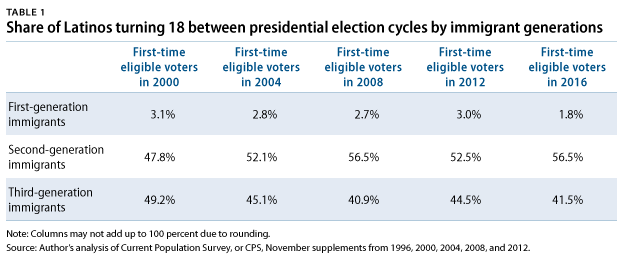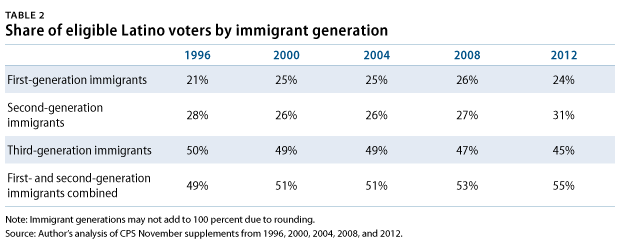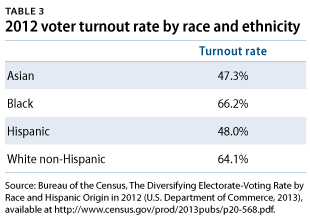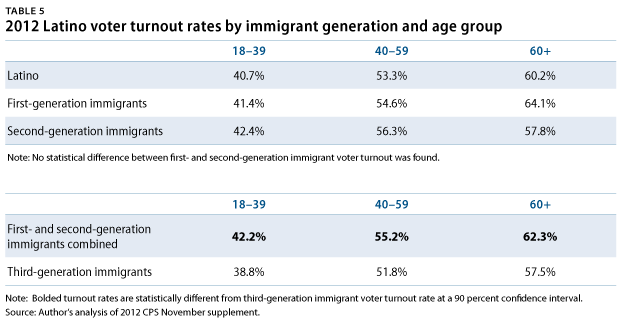It has been nearly one year since the Senate passed a bipartisan immigration bill—the Border Security, Economic Opportunity, and Immigration Modernization Act—and since then, the House of Representatives has done little to move the process of reform forward in any meaningful way. With the November 2014 congressional and 2016 presidential elections just around the corner, the window of opportunity for the current House to pass immigration reform is closing quickly. As House Republican leaders consider whether they will take action on reform this congressional session, they should remember that the time to pass reform is not the only thing that is coming to an end; the window of opportunity to gain support among Latino voters for the upcoming elections is also quickly closing.
In the last two election cycles, Latino voters have been vital to Democrats’ victories in both the congressional and presidential races. Senate Majority Leader Harry Reid (D-NV), for example, won 90 percent of the Latino vote in 2010, allowing him to narrowly fend off his Republican challenger, Sharron Angle. Similarly, Latino voters helped secure President Barack Obama’s 2012 win in key states such as Colorado and Virginia, with 71 percent of Latinos supporting him nationally. In the days following the 2012 presidential election, a stunning array of conservative pundits and lawmakers, including Bill O’Reilly, asserted that the Republican Party must gain the support of Latino voters if it wished to be a viable party in future elections. They were correct: The influence of Latinos is only increasing as they become a larger share of the U.S. electorate.
Second-generation immigrants—the children of immigrants—are the fastest-growing segment of the Latino electorate. This means that the vast majority of the nearly 2,000 Latinos who turn age 18 and become eligible to vote each day come from an immigrant household. These young voters have witnessed firsthand the negative consequences of our broken immigration system and are acutely aware of the immigration reform debate occurring in our country. Thus, the House Republicans’ continued rejection of immigration reform alienates the fastest-growing segment of the Latino population. While House Republicans have a chance to redeem themselves with the Latino electorate before the 2014 and 2016 elections, it is clear that if they do not take up immigration reform soon, they will cement their future political demise.
This issue brief breaks down the Latino electorate by immigrant generation. Specifically, we identify the portions of the Latino electorate that are immigrants, the children of immigrants, and third-generation immigrants. Moreover, the analysis shows that second-generation immigrants are the driving force behind the growth of the Latino electorate. The findings of this brief provide further evidence that if Republicans do not help fix our immigration system soon, they will continue to isolate the Latino electorate.
Here are the key findings from the Center for American Progress’s analysis of the Latino electorate and the implications it will have on future elections:
- Immigrants and their children are an increasing share of the Latino electorate. Immigrants and their children made up 49 percent of eligible Latino voters in 1996. This share climbed to 55 percent by 2012.
- Second-generation immigrants are the driving force behind the growth of the Latino electorate. Between 2012 and 2016, 3.3 million Latino citizens will turn age 18. Of these, 57 percent, or nearly 2 million, are the children of immigrants.
- Immigrants and their children are more likely to vote than third-generation immigrants. Therefore, as immigrants and their children become a larger share of the Latino electorate, the voter turnout rate for Latinos will likely increase.
- As immigrants and their children make up a larger share of the Latino electorate, the importance of immigration reform will only continue to grow for the electorate as a whole.
For the purposes of this brief, key terms are defined as follows:
- First-generation immigrants: Individuals who were born abroad and moved to the United States. Only first-generation immigrants who are naturalized citizens are eligible to vote.
- Second-generation immigrants: Individuals born in the United States who have at least one parent who is an immigrant.
- Third-generation immigrants: U.S.-born individuals whose parents were born in the United States.
- Eligible voters: All U.S. citizens who are 18 years of age or older.
- Voter turnout rates: The share of all eligible voters who voted.
- Immigrant household: A household with at least one immigrant member.
Changing demographics of the Latino electorate
The Latino electorate is growing at a faster rate than many other racial and ethnic groups and therefore is becoming a larger share of the U.S. electorate; In 2012, Latinos accounted for 11 percent of all eligible voters. The Latino electorate will increase by 17 percent from 2012 to 2016. But what is the source of its growth?
In the early 2000s, second-generation Latino immigrants became the driving force behind growth in eligible Latino voters. Specifically, in 1996, third-generation immigrants were the largest share of Latinos turning age 18 over the next four years. But by 2000, second-generation immigrants accounted for more than 50 percent of all Latinos turning age 18 between 2000 and 2004.

Given that a majority of all Latino citizens younger than age 18—and 52 percent of all Latino citizens under age 5—were second-generation immigrants in 2012, the trend of second-generation immigrants leading the growth of the Latino electorate will continue for several presidential election cycles. Between 2012 and 2016, for example, 57 percent of the 3.3 million Latinos who will turn age 18 and be eligible to vote will have at least one immigrant parent. This means that immigrants and their children will become a larger share of the overall Latino electorate. It also means that the fastest-growing segment of the Latino electorate has lived or grown up in an immigrant household; this group of potential voters has witnessed our immigration system’s impact on their families and is personally invested in the current immigration debate.

First- and second-generation immigrants are most likely to vote
Even though Latinos are becoming a growing portion of the electorate and their potential influence on elections is rising, this group has historically had a low voter turnout rate and thus has not reached its political potential. The national Latino voter turnout rate was 48 percent in 2012, compared with 64 percent for non-Hispanic whites. Similarly, the share of Latinos who were registered to vote was 58.7 percent compared with 73.7 percent for non-Hispanic whites. This indicates that Latinos both register and turn out to vote at lower rates than many other racial and ethnic groups.

An analysis of data from the Census Bureau, however, suggests that not all Latinos have low voter turnout rates. Among the Latino electorate, immigrants and their children—meaning first- and second-generation immigrants—have historically been more likely to go to the polls than third-generation immigrants. In nearly every presidential election since 1996, there has been a statistically significant difference in voter turnout rates between immigrants and their children and third-generation immigrants.

To be sure, the difference in voter turnout rates across immigrant generations may be partly due to variation in the average age of voters across immigrant generations. It is common across racial and ethnic groups for voter turnout rates to vary by age group, with older cohorts voting at higher rates than younger groups. In 2012, for example, the voter turnout rate for Latinos ages 18 to 39 was 42 percent, while it was 62 percent for Latino voters ages 60 and older.
The mean age of eligible voters is 50 years for first-generation Latino immigrants, 34 years for second-generation Latino immigrants, and 41 years for third-generation Latino immigrants. When we compared voter turnout rates between immigrant generations by age group, immigrants and their children still had a higher voter turnout rate than third-generation immigrants. Simply put, those coming from an immigrant household are more likely to go to the polls and vote than someone who does not come from an immigrant household.

Impact on future elections
There are two main implications of the fact that second-generation immigrants will constitute a larger portion of the Latino electorate in future elections:
- The voter turnout rate of Latinos will likely rise.
- Immigration reform will likely become an even more salient issue for Latino voters.
Increased voter turnout
Given that a larger share of the Latino electorate will come from immigrant households in future elections, as well as the fact that immigrants and their children tend to have higher voter turnout rates than third-generation immigrants, it is probable that as more of this cohort enters the electorate and ages, the voter turnout rate for the Latino electorate as a whole will increase.
Specifically, because second-generation immigrants have higher voter turnout rates than third-generation immigrants and because the second generation is becoming a larger share of the electorate, it follows that voter turnout rates for the Latino population at large will likely increase. This relationship, however, is not a new one. Looking back to 1996, there are periods over which first- and second-generation immigrants became a larger share of the Latino electorate, and at the same time, the voter turnout rate for the Latino electorate as a whole had a statistically significant increase. For example, immigrants and their children went from being 49 percent of the Latino electorate in 1996 to 51 percent in 2004. Over this period, the voter turnout rate for the Latino electorate as a whole increased, from 44 percent in 1996 to 47.4 percent in 2004.

But one should not assume that there is a direct causal relationship in the example above. While it is likely that the rising share of immigrants and their children contributed to the increase in the Latino voter turnout rates in previous elections, this demographic shift alone cannot explain the increase. There are a multitude of factors, such as voting drives, which might have also contributed to increasing the Latino voter turnout rate. Looking forward, though—if all others factors are equal—as immigrants and their children make up a larger share of the electorate, the Latino voter turnout rate will likely increase over time.
Increasing importance of immigration reform
If immigration reform is not passed this year, then the significance that Latinos voters give to immigration reform in future elections will probably increase because the Latino electorate will be more closely connected to the immigrant experience than in years past. As first- and second-generation Latino immigrants grow as a share of the electorate, their direct experience with the immigration system will likely increase the importance of immigration reform as a policy priority across the Latino electorate as a whole.
The policy views that second-generation immigrants hold today are another indication that immigration reform will be a greater priority among the Latino electorate in future elections. Across immigrant generations, second-generation immigrants are the most likely to believe that immigration reform should be passed before the next election. In a recent poll, 76 percent of second-generation Latino immigrants thought Congress and President Obama should address immigration reform before the next election, compared with 71 percent and 68 percent of first- and third-generation Latino immigrants, respectively.
Second-generation immigrants and 18- to 39-year-old voters polling on immigration reform
Second-generation immigrants are the driving force behind the growth of the Latino electorate. By 2016, nearly 2 million second-generation immigrants will turn age 18 and be eligible to vote. While a majority of newly eligible Latino voters currently hold unfavorable views on how House Republicans are handling immigration reform, a majority of them have indicated in a recent Latino Decisions poll that if House Republicans pass immigration reform, Latinos would give them a second chance. According to the poll:
- 76 percent of second-generation Latino immigrants believe that it is “very important” or “extremely important” for Congress and the president to address immigration reform this year
- 69 percent of second-generation Latino immigrants disapprove of how Republicans in Congress are handling immigration policy
- 51 percent of second-generation Latino immigrants said they would be more favorable toward Republicans than they currently are if House Speaker John Boehner (R-OH) allows a vote on immigration reform this year
Latino voters who are 18 to 39 years old also place great importance on passing immigration reform and express similar disapproval of how congressional Republicans are handling it. According to the recent Latino Decisions poll:
- 63 percent of eligible Latino voters ages 18 to 39 believe that it is “very important” or “extremely important” for Congress and the president to address immigration reform this year
- 66 percent of eligible Latino voters ages 18 to 39 disapprove of how Republicans in Congress are handling immigration policy
- 53 percent of Latinos ages 18 to 39 said they would be more favorable toward Republicans than they currently are if House Speaker Boehner allows a vote on immigration reform this year
While it is impossible to know how a future electorate will view a specific policy such as immigration reform, most recent polling indicates that the second-generation immigrant population tends to place greater importance on immigration reform than other generations. This is not surprising given that for some second-generation immigrants, their parents, siblings, or other family members are undocumented, meaning that these second-generation immigrants have witnessed their family members bear the brunt of our broken immigration system. In fact, 68 percent of second-generation Latino immigrants have a family member or close friend who is undocumented. Thus, as second-generation immigrants become a larger share of the electorate, the share of the Latino electorate at large that views immigration reform as a policy priority will likely increase.
Conclusion
In recent congressional and presidential elections, the Latino electorate has proved to be extremely influential. And this political influence continues to grow each day as nearly 2,000 Latinos turn age 18 and become eligible to vote. All told, 3.3 million Latino citizens will turn age 18 between 2012 and 2016. Nearly 60 percent of these newly eligible Latino voters will be second-generation immigrants. These children of immigrants have witnessed firsthand the impact our broken immigration system has on their families and their friends. CAP’s analysis found that immigrants and their children vote at higher rates than third-generation immigrants. Thus, as immigrants and their children become a larger share of the Latino electorate, the voter turnout rate for Latinos will likely increase, and fixing our immigration system will become a greater priority than in previous elections.
As the window of opportunity for the current House to pass immigration reform closes, so too does the chance for Republicans to gain the support of the Latino electorate in the 2014 and 2016 elections. There are nearly 2 million second-generation Latino immigrants who are coming of age and will be eligible to vote for the first time in 2016. If Republicans want to have a fighting chance in the 2016 election, they must appeal to the new electorate, and they can do so by passing immigration reform.
Patrick Oakford is a Policy Analyst in the Economic and Immigration Policy departments at the Center for American Progress.
The author would like to thank Angela Maria Kelley, Marshall Fitz, Philip E. Wolgin, and Ann Garcia for their helpful comments and suggestions.